Trevor Mackenzie and Rebecca Bathurst-Hunt (with the help and inspiration of Sylvia Duckworth) have used sketchnotes in their books as a way to capture their teaching learning in an easily understood visual. I am going to use their visuals as a jumping off point to discuss my thoughts, past experiences, and hopes for the inquiry process in my classroom going forward.
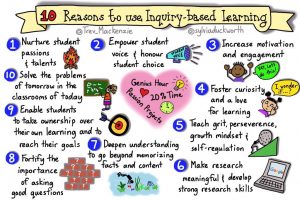 10 REASONS…
10 REASONS…
Trevor started out with this visual and asked us to reflect on our own teaching and come up with one or two of these that are evident in our classrooms. Personally, I chose number three. If you were to walk into my classroom and hang out at the back for a week, you would notice that I am intentional in my community building and fostering connections with each one of my students. As this grows and develops over the year, students become more comfortable to take risks in their learning. Therefore, they are more engaged in what they are doing. That in conjunction with planning exciting and fun activities throughout the year such as: a hands on dissection of a local Coho Salmon, making root beer floats to explore the properties of solids, liquids, and gasses, and participating in the creation of an art piece by Qwalacktun (Rick Harry) that is now on display at the West Vancouver Police Department.
In taking more time to look at this visual, and hearing reflections from my classmates, I am realizing that I need to take the time to be more intentional in some of the other areas. And as Trevor Mackenzie noted, these things do not happen every day but over time and you will develop strategies to put into your ‘toolkit’ of how to emulate those characteristics in your own classroom.
This would be a great visual to reference with a whole staff in order to identify where staff individual strengths lie and where they feel they need more work/support. It would open up a great dialogue and naturally flow into individual, small group, and whole group professional development.
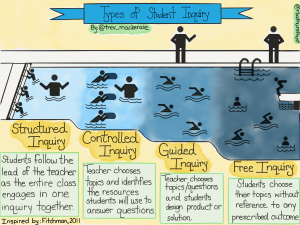 TYPES OF INQUIRY
TYPES OF INQUIRY
This visual demonstrates the different types of inquiry. Throughout the year, Trevor moves from one to the next – starting at structured and ending in free. His context is a little different because he is a middle school teacher and has limited time with his students in the week.
As an elementary school teacher, we have the flexibility to be wading in and out of these different areas throughout the days, weeks, and months. Personally though, I find that I spend most of my time in the shallower end of the pool. With my young students we move through the first three levels as the year progresses. There are so many foundational skills that we need to develop as a group before they are even ready to think about free inquiry. My grade two and three students are developing their questioning techniques, practicing their non-fiction reading skills and strategies, learning how to take notes, learning how to research online, digital literacy, and the list goes on….However, my goal this year is to make it to the deep end! I am moving into an older grade level and working with colleagues that are excited, supportive, and experienced with inquiry in the intermediate classroom.
What about Inquiry in Kindergarten? One would think that everything in Kindergarten is inquiry based learning, and to some extent it is. But in order to make it relevant to students, it needs to be meaningful. If you are a Kindergarten teacher in B.C. and you are wanting to know how to implement an inquiry mindset into your classroom, take a listen to Rebecca Bathurst-Hunt discussing her thoughts on the KindSight 101 Podcast last summer: Episode #32.
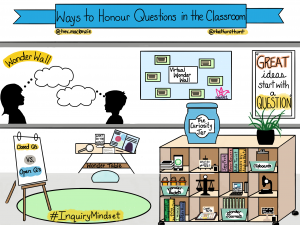 HONOURING QUESTIONS
HONOURING QUESTIONS
I find this visual so helpful as a reminder of making the thinking and learning visible in the classroom. I was inspired by Rebecca Bathurst-Hunt’s amazing Kindergarten room (you NEED to follow her on Instagram: @inquiryteacher) and created a ‘Wonder Wall’ on the old blackboard that covers one wall. The students pondering faces were adorable, however, I never used their thinking bubbles. The students would come up with questions and I would write them on the board or put them down on a KWL chart. I like the idea of having a wall, but when the kids are so little, it becomes a teacher make work project to write down all their questions that come up at random times during the day.
However, after seeing this visual it got me thinking. As I am moving into an older grade, I am thinking that it would be so cool to have a virtual ‘Wonder Wall’ where students are curating their wonderings, research, and findings on a digital platform where myself and parents can check in at any time!
Trevor also mentioned the Question Formulation Technique (QFT) as a way for students to developing their questioning ability. This technique allows for students to come up with as many questions as they can on a topic, allows for identification of open and closed questions, and discussion of the importance of both, and prioritize the ones that they come up with.
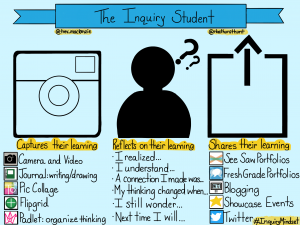 THE INQUIRY STUDENT: CAPTURES, REFLECTS, AND SHARES THEIR LEARNING
THE INQUIRY STUDENT: CAPTURES, REFLECTS, AND SHARES THEIR LEARNING
This visual is so straightforward and easy – but a great reminder about what to do at the end of a learning cycle in order to deepen the understanding. Rebecca and Trevor suggest ways in which students and teachers can capture the learning, prompts for reflection, and some avenues for sharing it out.
Often I find that students learn new things in class but don’t always know the purpose, especially in socials and science. Really, the whole purpose of learning is to acquire competencies to communicate, think, and build and nurture relationships with ourselves and each other. In order to make learning relevant to them, students need to know what the purpose of the learning is, how to capture that learning effectively, reflect on the importance, and be able to share it with a particular audience (parents, peers, other teachers, people around the world).
Voice and choice is an important concept for teachers and students. Teachers need to be modeling this to their students in their teaching by taking risks, sharing, and teaching in different ways. Therefore, at the end of a learning cycle, students can start reflecting on their own about who their audience is and what and how they are sharing their understanding of a concept. I want to try out some of these applications with my students this year. That way, I am demonstrating my own ability (to my staff AND students) to be vulnerable and try something new.
As we listen to more and more guest speakers share on the topic of social media, a common thread that keeps coming up is ethics and privacy. I need to make sure, for the sake of my students and families, that these great technology initiatives and apps are within my districts privacy policies. This is even more important as I move into my role as administrator. Myself, as well as staff, students, and parents needs to have a clear understanding of our responsibility , the rules and policies in place, and a mutual agreement of how we are going to use the materials we have. I am thinking of putting the outline of a technology agreement together in discussion with my school community so that everyone is on the same page and clear about what is going on online.
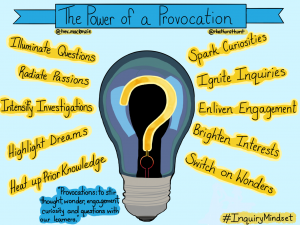 THE POWER OF A PROVOCATION
THE POWER OF A PROVOCATION
The power of a provocation provides students with an opportunity to engage in something new and exciting. Students are immediately engaged and naturally curious. There are so many examples of provocations out there:
– Field Trips, Experiments, Challenges (STEM, STEAM), Hands on activities, Explorations, Book, Photo, Video, Artifact, Special Guest, etc.
Trevor mentioned that in his middle school class, he sends out a ‘What are you passionate about?’ survey to all his students at the beginning of the year. This gives him to opportunity to target students who seemingly don’t have passion while also weaving in the interests of other classmates.
And sometimes, provocations are unplanned. A phrase that I really enjoyed from Trevor was ‘the magic pivot’. In this, he was referring to the ability to drop everything that was previously planned, and go with the students interests. It is a hard thing to do, especially in the older grades where there is so much content to get through! But WE KNOW that students are more engaged in their learning when they are interested, passionate, and hands on.
I definitely struggle with this one. I am still very much a student product of the system that I went through. I sometimes fall back on easy and reproducible activities in the classroom and get wrapped up in the stress of having to get through all of the curriculum – core competencies, curricular competencies, and content. My goal this year is to push myself in some of the other inquiry domains that Trevor and Sylvia show in the first image in this blog post.
My confidence and understanding of inquiry based education is always evolving and I am looking for implementing some of these new ideas into my school community!
This is a great summary! I was also pretty inspired by what Trevor does. I have always been really interested into the idea of inquiry, and in my work with math have really pushed an exploration problem solving mindset…but have had such a brain freeze when I try to expand it to senior math and science classes…and have always used “the curriculum” as a general excuse not to go down the rabbit hole.
Your students are lucky to have you!